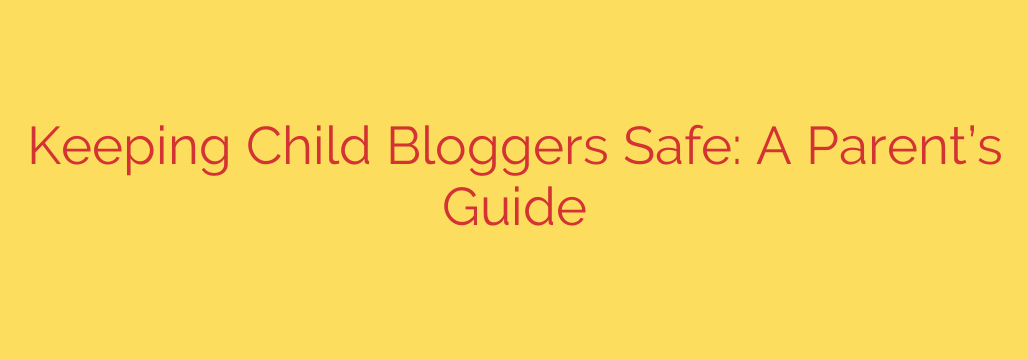
A Parent’s Guide to Safe Blogging for Kids: Essential Online Safety Tips
In today’s digital world, it’s no surprise that children are eager to create and share online. Blogging can be a fantastic outlet for a child’s creativity, helping them develop strong writing skills, technical literacy, and a confident voice. However, opening a door to the online world requires careful supervision and clear safety guidelines.
As a parent, your role is to empower your child to explore their passions while ensuring their digital environment is secure. This guide provides actionable steps to help you navigate the world of youth blogging and keep your child safe.
Establish a Strong Foundation: The Rules of the Road
Before the first blog post is even written, it’s crucial to sit down with your child and establish clear ground rules. This isn’t about limiting their creativity; it’s about creating a safe framework for them to express themselves.
1. Master Privacy and Anonymity
The most critical rule of online safety is protecting personal information. Teach your child that their online persona should be different from their real-world identity.
- Never share your child’s full name, school, address, or phone number. Use a fun alias, a nickname, or just their first name.
- Disable location tagging on all photos and within the blog platform’s settings. A picture taken in the backyard can reveal more about your location than you think.
- Use general terms for their location. Instead of “our neighborhood in Springfield,” they can say “a suburb in the Midwest.”
- Review photos carefully before posting. Check for school logos on clothing, visible house numbers, or license plates in the background.
2. You Are the Editor-in-Chief
Until your child is mature enough to understand the long-term consequences of their digital footprint, you must act as the final gatekeeper for all content.
- Review every post and photo before it goes live. This is non-negotiable. Check for any accidental sharing of private information and ensure the content is appropriate.
- Enable comment moderation. This is one of the most powerful tools at your disposal. Set the blog’s settings so that you must approve every single comment before it appears publicly. This allows you to filter out spam, trolls, and inappropriate messages before your child ever sees them.
Navigating the Social Side of Blogging
A blog isn’t just a publication; it’s a community. Your child will likely interact with readers through comments, and it’s essential to prepare them for both positive and negative encounters.
3. Prepare for Cyberbullying and Negative Feedback
While you can filter comments, it’s still important to prepare your child for the reality that not everyone online is kind.
- Discuss the possibility of negative comments. Explain that people sometimes say hurtful things online because they can hide behind a screen.
- Create a clear plan for handling negativity. The best strategy is often to ignore, delete, and block the user. Teach your child never to engage with a bully, as it only fuels the fire.
- Maintain open communication. Ensure your child knows they can come to you about any comment or interaction that makes them feel uncomfortable, sad, or scared, without fear of losing their blogging privileges.
4. Teach the Concept of a Digital Footprint
Help your child understand that the internet is permanent. What they post today could be seen by college admissions officers, future employers, and friends for years to come.
- Explain that “delete” doesn’t always mean “gone forever.” Screenshots and web archives can preserve content indefinitely.
- Encourage them to think before they post. A good rule of thumb is: “Would you be comfortable with your teacher or grandparents seeing this?” If the answer is no, it doesn’t belong on the blog.
Technical and Platform Considerations
Choosing the right tools and understanding the digital environment can significantly enhance your child’s safety.
5. Choose the Right Blogging Platform
Not all platforms are created equal. Look for services that offer robust parental controls and strong privacy settings. Platforms designed specifically for younger users or those with granular control over comments and visibility are often the best choice. Prioritize platforms that make it easy to moderate comments and keep the blog private or friends-only if desired.
6. Turn Off Private Messaging
If the blogging platform has a direct or private messaging feature, it should be disabled. Your child should not have private conversations with strangers. All communication should happen publicly in the moderated comment section, where you can oversee it.
By taking these proactive steps, you can create a safe and constructive environment for your child to thrive as a young blogger. The goal is not to eliminate all risk but to manage it effectively, teaching your child invaluable lessons about digital citizenship and online responsibility along the way.
Source: https://www.kaspersky.com/blog/how-to-help-child-blogger-2/54148/








